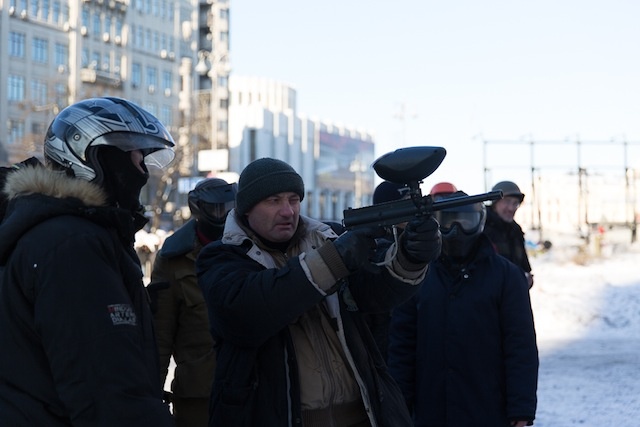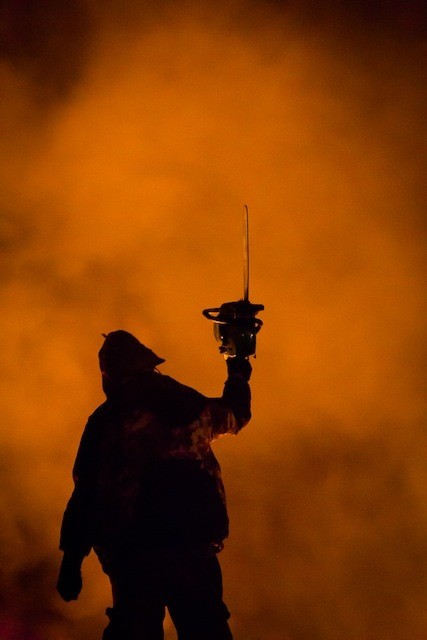The ceasefire brokered on Thursday in Kiev between police and Euromaidan protesters didn't hold out; last night, the barricades were burning again. More government buildings were stormed in other cities across the country, with clashes even reported in Sumy, a city that's usually staunchly pro-government.Discontent also spread to the ruling party, with a number of deputies and ambassadors resigning in protest against the violence and deaths of the past few days.
Advertisement
After Thursday's talks between opposition leaders and the government failed to establish a peace deal, President Viktor Yanukovych announced that there would be a cabinet re-shuffle. He also pledged to backtrack on some of the new laws that demonstrators are angry about, and awarded amnesty to a number of protesters arrested for minor offences.However, his attempt to placate the crowd in central Kiev failed; they want him out – perhaps even more so now that he has promoted his aide Andriy Klyuyev, who many of the opposition hold responsible for the police violence, to become his chief of staff.

It was apparent during the ceasefire that the situation was never going to stay calm; the protesters' barricades grew in size and number, more catapults were moved forward and a few guys were practicing their aim with their paintball guns. We asked them what they were doing and one protester told me: "We aim for the head, to hit them in their helmet visor so they can't see."We went to Hrushevskoho Street, the scene of the clashes, in the early afternoon. More barricades had been erected and some protesters were now armed with pitchforks. I first wondered whether this was some kind of visual pun – the international symbol of an angry mob, protesters making Yanukovych out to be an evil creature who refuses to die. But given the levels of violence we've seen, I'm pretty sure they were actually just planning on skewering some cops.
Advertisement
At around 9PM, clashes broke out on Hrushevskoho, turning the area into a battlefield. No one is really sure how the violence started again – some protesters we spoke to claimed that the police randomly opened fire with rubber bullets, others say the police were provoked when protesters moved one of their barricades forwards.Either way, the chaos was in full swing, and the newest tire barricade was quickly set alight, filling the sky with thick, acrid smoke and generally making everything look like the opening scene of an apocalypse movie. Activists moved in groups of around six to fuel the tire fire with petrol and more tires. In an effort to stop them, the police and fire service started spraying them with water. It's about minus 15 degrees here, so any water you're hit with freezes almost instantly. I took a blast when I moved closer to the fire; my cameras froze solid and the water dripping off my helmet turned into icicles.

The police action was relatively restrained compared to previous days. There were no baton charges or other instances of hand-to-hand fighting – they preferred to keep things at a distance. The protesters brought their catapults to the front-line and began hurling petrol bombs and rocks towards the police. The catapults are operated by a crew of around ten, who spend a lot of time arguing over the target, elevation and type of ammo. Once the squabbling stops, one man pulls back the sling and another loads it with a petrol bomb, before launching it towards the police lines, hundreds of feet away. As ingenious as they are, the catapults aren't that accurate – the petrol bombs or stones occasionally ended up falling short and crashing into the protesters' barricades instead.
Advertisement
The cops responded with the occasional barrage of rubber bullets, flash bang grenades and the odd stone. A man next to me was hit in the leg by a rock the size of my fist and barely reacted. "I'm unlucky," he said. "At the beginning of Maidan, I was beaten in the head by the police – this is nothing."Both the protesters and the cops were employing spotters, the latter shining a spotlight towards the barricades looking for people throwing Molotovs. If they caught someone out, they'd fire a rubber bullet at them. The protesters had people watching the police, and when they threw a grenade or drew up their shotguns, a shout would ring out and people would take cover.

Everyone was tooled up, most armed with blunt instruments of some sort – clubs, pieces of wood, medieval maces, ice picks, hammers. But one man took his weapon game to another level entirely, standing on top of a burnt-out bus, half naked, while rotating a huge chainsaw in arcs around his head.More people were turning up as the clashes continued into the early hours, giving some at the front-line respite from the fire and freezing water. Extra tires were brought forward to create another barricade behind the one now engulfed in flames, while medics handed out gas masks and other protesters offered tea and sweets around to keep morale up.There's a community among the protesters here. Not everyone is fighting, but the ones who aren't manning the barricades are helping in any way they can. Further back, hundreds of protesters were continuously banging on discarded oil drums and walls.
Advertisement
As the hours dragged on, things started to quieten down; catapults were pulled back and the police lessened their use of stun grenades. By around nine in the morning, another fragile ceasefire had been agreed.It's hard to see how the police could hope to clear Hrushevskoho and Maidan with pure force. The barricades are getting stronger by the day and protesters are better prepared than ever before. Some are speculating that you would need more riot police than the government has at its disposal – driving bulldozers towards the barricades – if you really wanted to clear the protesters, pushing up the likelihood of bloodshed.Protesters have already been killed, but people are still here in the freezing cold, apparently willing to die for their cause. So far, politicians have failed to reach a compromise. And if they don't come up with a solution, the question becomes: How much further would the government and opposition want to push things here on the streets?Follow Henry (@Henry_Langston) and Phil (@Phil_Caller) on TwitterPreviously: Fighting in Kiev Has Stopped, But Everyone's Still Pissed Off
24th January 2013
24th January 2013
24th January 2013
24th January 2013
24th January 2013
24th January 2013
24th January 2013
24th January 2013
24th January 2013
24th January 2013
24th January 2013
24th January 2013

24th January 2013
24th January 2013
24th January 2013
24th January 2013
24th January 2013
24th January 2013